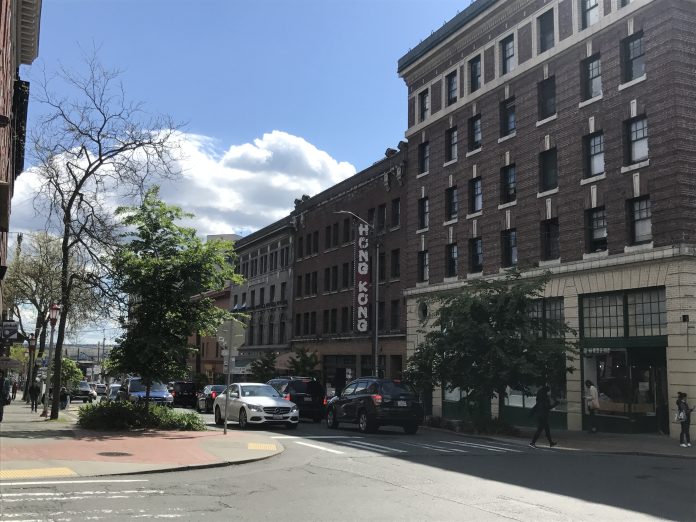An ordinance to rezone and revise development regulations for Chinatown-International District could move out of committee today. The Planning, Land Use, and Zoning (PLUZ) Committee is scheduled to meet this afternoon to discuss and possibly vote on amendments to an ordinance that would implement Mandatory Affordable Housing zoning changes throughout much of the neighborhood. The rezone would allow larger and taller buildings in most areas surrounding the historic Chinatown core. In exchange, developers would generally be expected to set aside 5% to 7% of their developments aside for affordable housing or pay fee in lieu to the City instead.
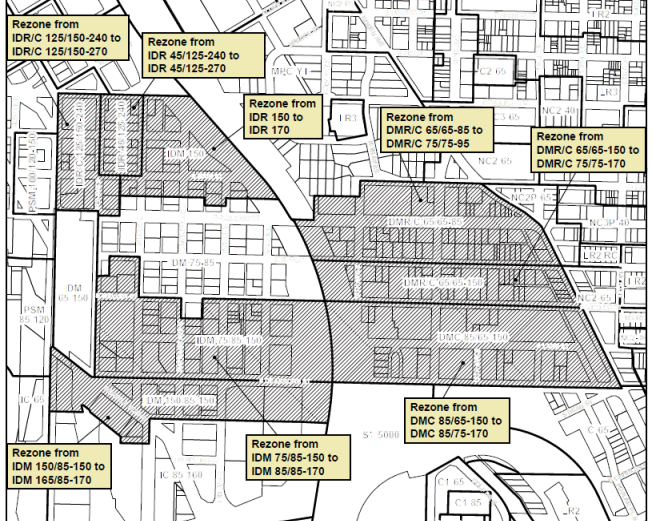
The rezone proposal would also retain existing incentive zoning requirements that serve to provide public benefits, such as preservation of open space and historic landmarks, development of privately-owned public spaces (e.g., public open space, public atriums, human services uses, and public restrooms), contributions to affordable housing, and construction of Neighborhood Green Street improvements.
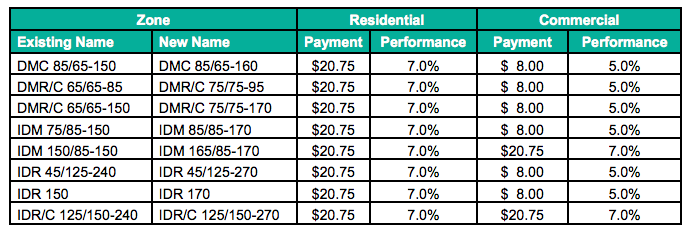
The proposed neighbor rezones would deliver development capacity increases in a variety of ways:
- Commercial allowances. Commercial development capacity is generally proposed to increase by 0.5 to 1.0 FAR (floor area ratio). In some cases, capacity would increase in terms of allowed building heights.
- Residential allowances. Residential development capacity is generally proposed to increase by increasing building heights. The Office of Planning and Community Development (OPCD) is recommending height increases from 10 to 30 feet, depending upon zone.
- Tower floorplates. In zones where towers are permitted, certain floorplate maximums would be slightly modified to account for what are considered “breakpoints” in development capacity and cost.
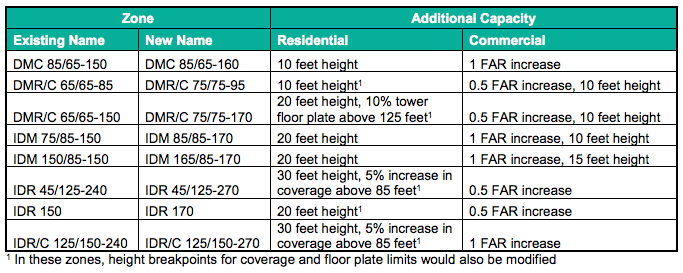
Specific amendments to the ordinance include revised boundaries to the local design review boards and International Special Review District, exempting large affordable housing projects from incentive zoning requirements in certain zones, and considering amendments to help locally-owned, small businesses in Little Saigon. To compliment the proposed ordinance, the City Council is sponsoring a companion resolution that would establish commitments, milestones, and specific actions to follow-on from adoption of the rezones and revised development regulations. Amendments to that resolution may also be proposed and adopted as part of the PLUZ meeting.
Amendments to the Ordinance
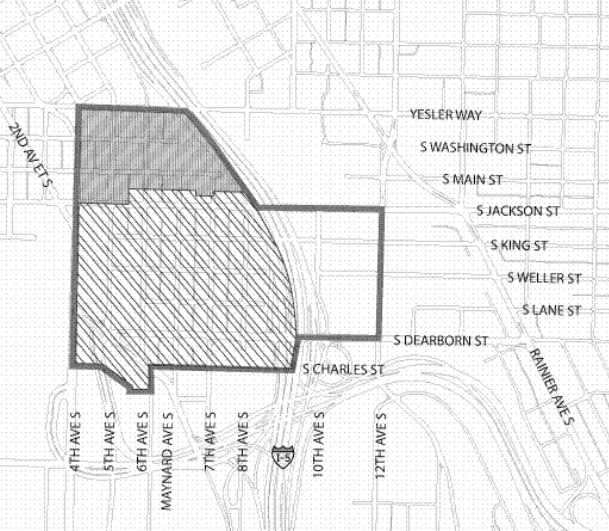
Amendment 1 to the ordinance would indeed revise the boundaries local design review boards and the scope of the International Special Review District (ISRD). The revisions would mean that the Downtown Design Review Board and ISRD would be coterminous with the boundaries of Chinatown-International District to effectuate common design guidance and special planning control across the whole neighborhood.
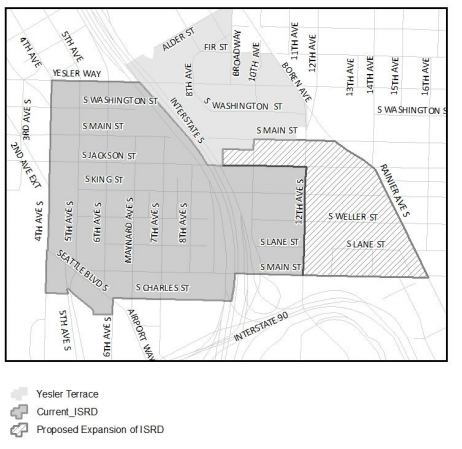
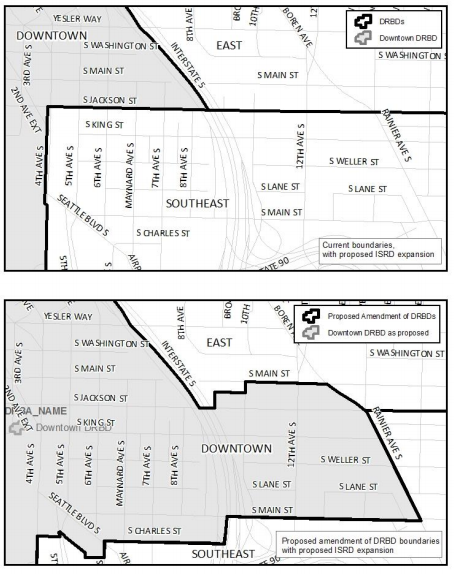
Additionally, the amendment would make changes to a handful of other maps that identify requirements related to general street classifications, sidewalk widths, pedestrian street classifications, required street-level uses, and facade requirements. The bulk of the changes in the maps a related to the proposed expansion of the ISRD, but one of the maps includes minor changes in the applicability of mapped regulating standards.
Amendment 2 to the ordinance is designed to allow large voluntary affordable housing projects in the Chinatown-International District to be exempt from mandatory participation in incentive zoning programs for any additional floor area above the base maximum allowed in the DMC, DMR, IDM, and IDR zones of South Downtown.
In zones where the maximum building height is limited to or less than 95 feet, all of the additional floor area must be achieved by providing affordable housing. For zones where the maximum building height is above 95 feet, at least 60% of the additional floor area must be achieved by providing affordable housing. Another 40% of the additional floor area must be achieved by preserving historic landmarks and open space through purchase of transfer of development rights, developing on-site privately-owned public spaces (e.g., public open space, public atriums, human services uses, and public restrooms), or constructing local Neighborhood Green Street improvements.
To qualify for the proposed exemption under the draft amendment, a development would have to:
- Receive public funding or Low-Income Housing Tax Credits from the federal government;
- Have a minimum of 40% of all units income-restricted to households making at or below 60% of the area median income; and
- Serve as affordable housing for at least 40 years either by covenant or other recorded property agreement with a local, state, or federal agency.
These kinds of large voluntary affordable housing projects are also already exempt from the MHA requirements (see SMC 23.58C.025.C) because they greatly exceed the affordable housing requirements built into the MHA program. Ultimately, the exemption and proposed exemption serve to encourage large voluntary affordable housing projects to be built by removing additional development requirements that could affect project financing.
Another set of issues and topics may be incorporated into the ordinance to address concerns related to locally-owned, small businesses in the Little Saigon precinct of Chinatown-International District. According to Council Central Staff’s memorandum:
Little Saigon, the part of the Chinatown/International District east of I-5, is seeing a significant amount of new development. As the neighborhood grows, the small, immigrant-owned businesses in Little Saigon face the threat of displacement. Business owners are concerned that as rents increase in the neighborhood and small one-story buildings are replaced with mixed-use towers, they will not be able to remain in the neighborhood. In 2016, in response to similar concerns from across the City, the Mayor convened a Commercial Affordability Advisory Committee. It developed a wide range of recommendations, some of which are directly related to land use and zoning.
The Council Central Staff memorandum outlines a variety of possible amendments or actions that could implement some of the recommendations:
| Commercial Affordability Advisory Committee Recommendation | Current Zoning in Little Saigon | Council Amendments | Discussion |
|---|---|---|---|
| Allow small pockets of commercial uses in residential areas | Commercial uses are allowed throughout Little Saigon; they are required along S Jackson S and the blocks of 12th Ave S that are directly north and south of S Jackson St. | Councilmember Herbold has proposed asking the Office of Planning and Community Development (OPCD) and the Department of Neighborhoods (DON) to review the uses permitted in Chinatown-International District (C/ID). | The City Council could ask OPCD to work with the community to review whether the list of uses that are permitted in the area and the uses that are required at street-level remain appropriate. |
| Limit signage to discourage franchise businesses | Signs are regulated in the ISRD (SMC 23.66.338), special design guidelines have been adopted for the ISRD. | Councilmember Johnson has proposed to extend the ISRD include all of Little Saigon. | The Council could ask DON to work with the community and ISRD board to review whether the design guidelines for signage need to be updated. |
| Require special permits for formula retail businesses | "Formula fast food restaurants" are subject to special review in the ISRD. | Councilmember Johnson has proposed to extend the ISRD include all of Little Saigon. | This special review is unique to the ISRD; the Council could ask OPCD to consult with the ISRD Board to determine whether there has been or is likely to be a preponderance of formula retail uses that could also be subject to special review. |
| Limit the length of store frontages occupied by a single tenant | In DMR zones (SMC 23.49.143): retail and restaurant uses are limited to 25,000 square feet and grocery stores are limited to 50,000 square feet, there are no frontage limits. In DMC zones (SMC 23.49.059): Abutting green streets, large grocery stores (greater than 50,000 square feet) and other large retail uses (25,000 square feet) must be separated from the green street for 75% of lot frontage. | Councilmember Herbold has proposed to ask OPCD and DON to review the maximum sizes of retail uses and the characteristics of storefront entrances and their spacing. | The Council could ask OPCD to work with the Little Saigon community to determine whether to change these limits or add additional requirements. |
| Support small businesses through design guidelines | The ISRD has specific guidelines for storefronts in the Asian Design Character District. | Councilmember Johnson has proposed to extend the ISRD include all of Little Saigon. | The Council can ask the ISRD Board and DON to review the guidelines to make sure that they support small businesses in Little Saigon. |
| Provide channels for communication of small business priorities through the development process | ISRD development review provides an opportunity for members of the community to discuss projects with developers throughout the development process. Community members have mentioned that out of this process, they have been able to work with developers to provide commercial spaces in new buildings that will work for small immigrant-owned businesses. | Councilmember Johnson has proposed to extend the ISRD include all of Little Saigon. |
Other amendments may be brought forward at the meeting in addition those outlined in the Council Central Staff memorandum.
UPDATE (6/6/2017): The PLUZ Committee adopted Amendments 1 and 2 to the ordinance and agreed to develop additional amendments to respond to community desires. Councilmembers agreed to develop amendments in the next week so that they could share them with community members prior to taking them up at a full City Council meeting in mid- to late-July. Possible amendments to be draft include incentivizing deeply affordable units at or below 50% of the area median income by allowing additional building height, mid-block requirements and other urban design standards, and increasing Mandatory Housing Affordability requirements. With Amendments 1 and 2 adopted, the ordinance was voted out of committee. Councilmember Rob Johnson expressed a commitment to take conservations on the legislation and additional amendments to the streets in Chinatown-International District to get feedback, holding open houses, and dropping in to speak with community groups.
Amendments to Companion Resolution
The proposed ordinance will have a companion resolution that specifies actions and commitments that the City will make in response to the rezone and urban design regulations:
| Number | Topic/Issue | Proposed Amendment | Discussion |
|---|---|---|---|
| 1 | This amendment would express Council’s recognition of the C/ID as a cultural home for diverse stakeholders and Asian Pacific Islander communities and declare the City’s commitment to help the C/ID. | Section 10. The Council recognizes the strong desire of diverse stakeholders and Asian Pacific Islander (API) communities to retain a "cultural home" in the C/ID; and that the future of the C/ID as a safe, vibrant neighborhood with a unique identity depends on placemaking, economic development, and community building by its residents and stakeholders. The City commits to exploring culturally- and linguistically-responsive strategies and resources that can help C/ID residents and stakeholders to best preserve and grow cultural, community, and business institutions as a diverse, unique neighborhood. | The commitment expressed in the resolution calls for "…exploring culturally- and linguistically-responsive strategies and resources that can help C/ID residents and stakeholders to best preserve and grow cultural, community, and business institutions as a diverse, unique neighborhood." |
| 2 | This amendment would add a statement of Council’s support for the work of a C/ID Advisory Committee, with special regard for the planning for the Charles Street property. | Section 3. The Council supports the efforts of a C/ID Advisory Committee, with City departments, to develop a framework and implementation plan for the C/ID, addressing topics such as: updates to the ISRD guidelines, community development and stabilization, strategic investment of City funds, public realm improvements, and an update to the Charles Street Campus Master Plan. The Council expects the updated planning for the City’s Charles Street property to consider a range of alternatives including streetscape improvements along S Dearborn St, partial redevelopment, and a long-term strategy for relocation of City facilities. | The Executive is in the process of forming a C/ID Advisory Committee to develop a framework and implementation plan for the C/ID, as described in the language of the amendment. The amendment supports this effort, in particular, calling out the update to the Charles Street Campus Master Plan. The Charles Street Campus is City-owned property that currently houses City engineering shops. It is between 8th Ave S and 9th Ave S, bounded by Dearborn to the north and I-90 to the south. S Charles St dead-ends to east into the property. The C/ID community has advocated for a more community-oriented use of these properties. |
| 3 | This amendment would amend the title of the resolution to include "economic vitality." | Inserts phrase "economic vitality" into the title of the companion resolution. | Sustaining the vital role the businesses in the C/ID play in the life of the region’s Asian and Pacific Islander communities has been a core theme of public comment on the proposed legislation. This amendment brings that theme into the title of the Resolution |
| 4 | This amendment would request that OPCD and DON ensure that specific issues are included in the consideration of changes to the ISRD rules and guidelines. | The Council requests that the Office of Planning and Community Development (OPCD) and the Department of Neighborhoods (DON) work with the C/ID community, stakeholders, and the ISRD Board to consider the following types of changes: - Reducing the maximum permitted size of retail uses; - Specifying important characteristics of storefront entrances and their spacing; - Amending the list of conditional uses; - Applying limits to formula retail uses; - Allowing administrative review for minor changes to buildings, rather than ISRD board review; - Providing authority to the ISRD board to grant departures from Land Use Code requirements; and - Changing the structure of the ISRD board. | The Council requests OPCD and DON work with the C/ID community, stakeholders, and the ISRD Board to consider particular types of land use, zoning and design review changes, based on community concerns. This amendment to the resolution is separate from the amendment to the bill that would increase the geographic area of the ISRD. |
| 5 | This amendment would affirm the City's commitment to continue to work with business community stakeholders in developing strategies to promote economic development and commercial stability. | Additional language would be added to clarify that the City will maintain continued dialogue the neighborhood business community as stakeholders. | This amendment would recognize the importance of the voices of the C/ID business community in developing and implementing strategies to support the continued economic vitality of the C/ID. |
| 6 | This amendment would add a deadline for a report on parks and public space improvements and reaffirm the City’s support for programming of public spaces in the C/ID and citywide. | The specified deadline would be September 2018 for a report and clarify that the report must include information on "the programming of positive activities." | This amendment would request that the Executive report by September 2017 on the timing and sequence of parks and public space improvements. It would also reaffirm the City's commitment to programming of public spaces in the C/ID. |
| 7 | This amendment would add two anti-displacement strategies to the resolution: reuse of publicly-owned property for housing and an unreinforced masonry preservation pilot. | The amendment would specify the following objectives: a. Support under the Equitable Development Initiative; b. Exploration of re-use of City-owned property and/or City partnership and support for re-use of property owned by other public entities for new affordable housing, affordable commercial/retail, and non-profit community uses in the neighborhood; and c. Support for an Unreinforced Masonry Preservation pilot to increase the supply of affordable housing on currently-vacant upper floors, and to sustain affordable commercial spaces on the ground floors by using funds from sources such as the Mandatory Housing Affordability (MHA) program, proceeds from the $29 million housing bond, and/or a targeted growth fund with revenues from an increment of increased property tax revenue from future growth, as appropriate. | This amendment would add two additional anti-displacement strategies for the Chinatown/International District. The first is exploring opportunities to reuse City and other publicly-owned property for affordable housing development in the neighborhood. The second is exploring a new Unreinforced Masonry Preservation pilot to increase the supply of affordable housing in vacant floors of buildings in the Chinatown/International District. The pilot program would be funded through MHA funds, proceeds from the $29 million housing bond approved by the Council in the 2017 budget, or a targeted growth fund with revenues from an increment of increased property tax revenue from future growth. |
UPDATE (6/6/2017): The PLUZ Committee adopted all of the amendments to the resolution, including a minor adjustment to the language regarding unreinforced masonry buildings. The resolution would be held for adoption until the corresponding ordinance is to be passed.
Next Steps
The PLUZ Committee has the option of voting on amendments at the meeting and sending the legislation onto the full City Council. If the legislation moves out of committee, the City Council could vote on the package of proposals in the coming weeks.
Chinatown-International District – Central Staff Memo – 6-6-17
First Look: City Keys Up 5% To 7% MHA For Chinatown-International District Rezone
Stephen is a professional urban planner in Puget Sound with a passion for sustainable, livable, and diverse cities. He is especially interested in how policies, regulations, and programs can promote positive outcomes for communities. With stints in great cities like Bellingham and Cork, Stephen currently lives in Seattle. He primarily covers land use and transportation issues and has been with The Urbanist since 2014.

